Tran Sfer Of Property Act
•Télécharger en tant que PPS, PDF•
0 j'aime•351 vues
PRESENTATION USED FOR PGPSE PARTICIPANTS OF AFTERSCHOOOL. JOIN AFTERSCHOOOL - IT IS THE BEST WAY TO BECOME AN ENTREPRENEUR AND WORK FOR SOCIAL DEVELOPMENT
Signaler
Partager
Signaler
Partager

Recommandé
Recommandé
Leading Your Team to Greatness- Dr. James Goenner, National Charter Schools I...

Leading Your Team to Greatness- Dr. James Goenner, National Charter Schools I...National Charter Schools Institute
Contenu connexe
Tendances
Leading Your Team to Greatness- Dr. James Goenner, National Charter Schools I...

Leading Your Team to Greatness- Dr. James Goenner, National Charter Schools I...National Charter Schools Institute
Tendances (17)
Leading Your Team to Greatness- Dr. James Goenner, National Charter Schools I...

Leading Your Team to Greatness- Dr. James Goenner, National Charter Schools I...
Good to Great by Jim Collins - A brief book review in PPT format.

Good to Great by Jim Collins - A brief book review in PPT format.
The fox and the hedgehog concepts in business- Do BIG business in a better way

The fox and the hedgehog concepts in business- Do BIG business in a better way
En vedette
En vedette (6)
Similaire à Tran Sfer Of Property Act
Leading Your Team to Greatness- Dr. James Goenner, National Charter Schools ...

Leading Your Team to Greatness- Dr. James Goenner, National Charter Schools ...National Charter Schools Institute
Similaire à Tran Sfer Of Property Act (20)
All hands on deck for siemens medical solutions western zone leadership retreat

All hands on deck for siemens medical solutions western zone leadership retreat
Truth Telling & Truth Suppression:Lies, Myths. and Realities

Truth Telling & Truth Suppression:Lies, Myths. and Realities
Joe Tye Presentation for Georgia Hospital Association Trustee Conference, Feb...

Joe Tye Presentation for Georgia Hospital Association Trustee Conference, Feb...
Leading Your Team to Greatness- Dr. James Goenner, National Charter Schools ...

Leading Your Team to Greatness- Dr. James Goenner, National Charter Schools ...
The Physics of Cultural Transformation, Joe Tye Webinar for AHA Health Forum,...

The Physics of Cultural Transformation, Joe Tye Webinar for AHA Health Forum,...
QCS Leadership Conference 2019 - Managing Change From The Inside Out & Strate...

QCS Leadership Conference 2019 - Managing Change From The Inside Out & Strate...
The Florence Prescription, Ohio State University College of Nursing, 8-20-15

The Florence Prescription, Ohio State University College of Nursing, 8-20-15
Planned Change in Organizations SOSC 4315 - Feb 4 Presentation

Planned Change in Organizations SOSC 4315 - Feb 4 Presentation
The Entrepreneurial Dream: The Power Of Entrepreneurial Thinking

The Entrepreneurial Dream: The Power Of Entrepreneurial Thinking
Persuasion Equation The Subtle Science of Getting Your Way.docx

Persuasion Equation The Subtle Science of Getting Your Way.docx
Joe Tye presentation to Georgia Hospital Association Patient Safety Summit wi...

Joe Tye presentation to Georgia Hospital Association Patient Safety Summit wi...
Dernier
Best Practices for Implementing an External Recruiting Partnership

Best Practices for Implementing an External Recruiting PartnershipRecruitment Process Outsourcing Association
Dernier (20)
Russian Faridabad Call Girls(Badarpur) : ☎ 8168257667, @4999

Russian Faridabad Call Girls(Badarpur) : ☎ 8168257667, @4999
Lucknow 💋 Escorts in Lucknow - 450+ Call Girl Cash Payment 8923113531 Neha Th...

Lucknow 💋 Escorts in Lucknow - 450+ Call Girl Cash Payment 8923113531 Neha Th...
Cash Payment 9602870969 Escort Service in Udaipur Call Girls

Cash Payment 9602870969 Escort Service in Udaipur Call Girls
0183760ssssssssssssssssssssssssssss00101011 (27).pdf

0183760ssssssssssssssssssssssssssss00101011 (27).pdf
Yaroslav Rozhankivskyy: Три складові і три передумови максимальної продуктивн...

Yaroslav Rozhankivskyy: Три складові і три передумови максимальної продуктивн...
BEST ✨ Call Girls In Indirapuram Ghaziabad ✔️ 9871031762 ✔️ Escorts Service...

BEST ✨ Call Girls In Indirapuram Ghaziabad ✔️ 9871031762 ✔️ Escorts Service...
Tech Startup Growth Hacking 101 - Basics on Growth Marketing

Tech Startup Growth Hacking 101 - Basics on Growth Marketing
Vip Dewas Call Girls #9907093804 Contact Number Escorts Service Dewas

Vip Dewas Call Girls #9907093804 Contact Number Escorts Service Dewas
VIP Call Girl Jamshedpur Aashi 8250192130 Independent Escort Service Jamshedpur

VIP Call Girl Jamshedpur Aashi 8250192130 Independent Escort Service Jamshedpur
Call Girls Pune Just Call 9907093804 Top Class Call Girl Service Available

Call Girls Pune Just Call 9907093804 Top Class Call Girl Service Available
Call Girls Navi Mumbai Just Call 9907093804 Top Class Call Girl Service Avail...

Call Girls Navi Mumbai Just Call 9907093804 Top Class Call Girl Service Avail...
VIP Kolkata Call Girl Howrah 👉 8250192130 Available With Room

VIP Kolkata Call Girl Howrah 👉 8250192130 Available With Room
Mysore Call Girls 8617370543 WhatsApp Number 24x7 Best Services

Mysore Call Girls 8617370543 WhatsApp Number 24x7 Best Services
Keppel Ltd. 1Q 2024 Business Update Presentation Slides

Keppel Ltd. 1Q 2024 Business Update Presentation Slides
Best Practices for Implementing an External Recruiting Partnership

Best Practices for Implementing an External Recruiting Partnership
Tran Sfer Of Property Act
- 1. ORGANISATIONAL BEHAVIOUR AFTERSCHO ☺ OL – DEVELOPING CHANGE MAKERS CENTRE FOR SOCIAL ENTREPRENEURSHIP PGPSE PROGRAMME – World’ Most Comprehensive programme in social entrepreneurship & spiritual entrepreneurship OPEN FOR ALL FREE FOR ALL www.afterschoool.tk AFTERSCHO☺OL's MATERIAL FOR PGPSE PARTICIPANTS
- 2. ORGANISATIONAL BEHAVIOUR Dr. T.K. Jain. AFTERSCHO☺OL Centre for social entrepreneurship Bikaner M: 9414430763 [email_address] www.afterschool.tk , www.afterschoool.tk www.afterschoool.tk AFTERSCHO☺OL's MATERIAL FOR PGPSE PARTICIPANTS
- 37. A Culture of Discipline
- 51. The Doom Loop